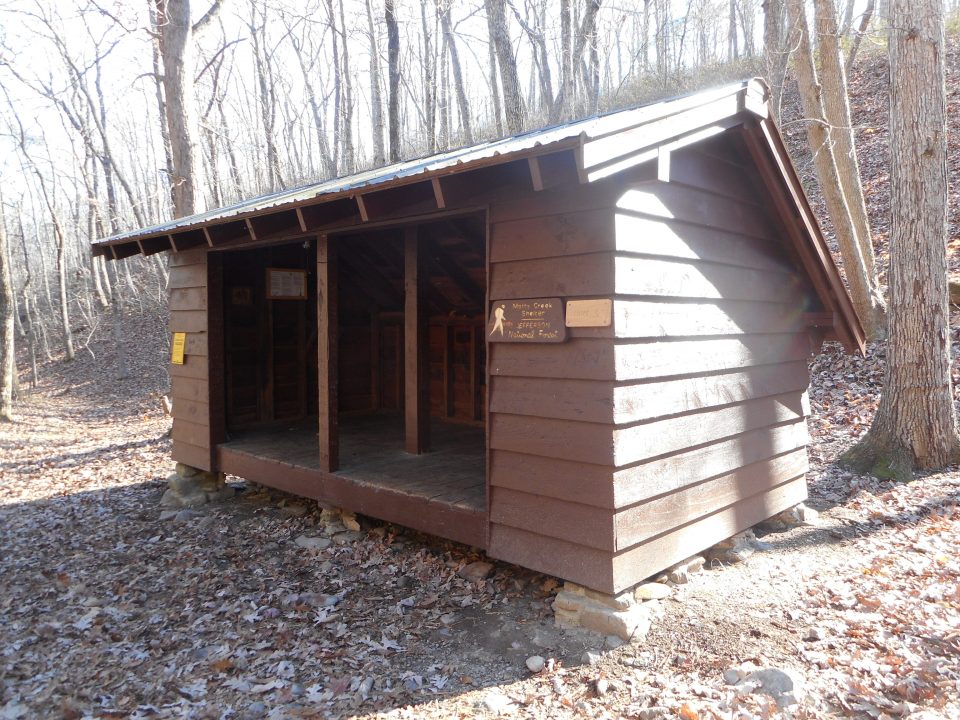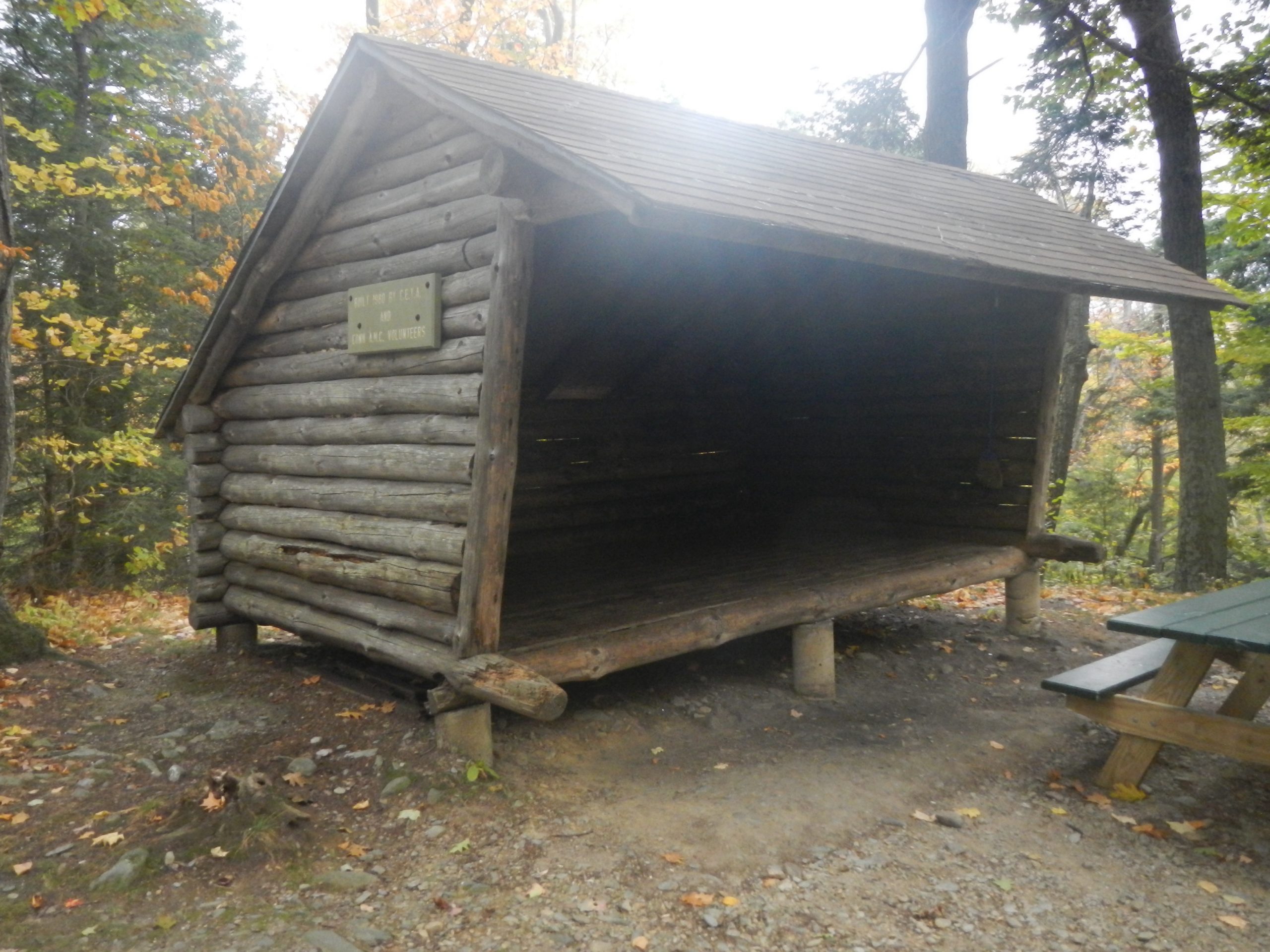America’s oldest mountain range stretches all the way from Georgia to Maine. And in between those states lies the Appalachian Trail, a journey over 2,000 miles that crosses through 14 states.
As you travel along the strenuous expedition you’ll come across the Appalachian Trail Shelters. You’ll want to be ready for whatever your travels throw at you. So, we sorted through over 250 trail shelters to find you two shelters from each state. That’s 28 shelters to choose from.
View in gallery
“Appalachian-Trail-271” (CC BY-SA 2.0) by John Hayes
Read below our state by state guide for navigating the Appalachian Trail Shelters.
Table of Contents
Georgia’s Appalachian Trail Shelters

1. Lumpkin, Georgia – Blood Mountain Shelter
The shelter at Blood Mountain has an elevation of 4450’. The Civilian Conservation Corps(CCC) constructed the stone shelter in 1937.
After close to a century, not much has changed with the Blood Mountain Shelter. Blood Mountain has incredible views, but can get windy at night. So, taking advantage of the shelter is a good idea.
Plus there’s something special about staying in a place so many Appalachian Trail hikers have stayed in before you.
2. Fannin, Georgia – Stover Creek Shelter
Stover Creek Shelter has an elevation of 2930’, which makes it the lowest elevation of Georgia Appalachian Trail Shelters.
There is a nearby creek that you can acquire water with but you’ll need to make sure it is filtered. Stover Creek Shelter also has bear bags and places to secure your food.
The shelter here is your standard Appalachian Trail lean-to but features a picnic table, benches, a loft, and ample space for multiple hikers.
North Carolina’s Appalachian Trail Shelters

3. Swain, North Carolina – Icewater Spring Shelter
The Icewater Spring Shelter in Swain, North Carolina has incredible architecture. You’ll find that incredible architecture is a common feature amongst the Appalachian Trail Shelters. It also sits at an elevation of 5,920’, so you can count on some breathtaking views.
The main structure is a lean-to with large columns out front, and a windowed loft. Hikers have access to a privy, cell service, and can choose to make a reservation for those peak months. There’s also drinking water available via a pipe, but you’ll definitely want to make sure you have a filter or can treat the water.
Icewater Spring Shelter is located close to a parking lot and is a great place to hike to if you’re just looking for a relatively low-maintenance daytrip.
4. Graham, North Carolina – Fontana Dam Shelter
Near the Fontana Dam in Graham, North Carolina, is one of the most modern Appalachian Trail Shelters. Simply dubbed the Fontana Dam Shelter, the structure is anything but simple.
Fontana Dam has an elevation of 1,775’ and differs from many shelters along the trail as it lacks a slanted roof.
There are several “luxuries” to partake in while you spend the night at Fontana Dam. You can enjoy access to drinking water, cell service, and a shower. There’s a porch overlooking a picnic area with a firepit. Plus the view of the lake is pretty amazing.
Tennessee’s Appalachian Trail Shelters

5. Carter, Tennessee – Laurel Fork Shelter
Laurel Fork Shelter in Tennessee’s elevation is 2,450’. There is a nearby waterfall so you can enjoy ample drinkable water.
The three-sided shelter was built in 1960 by the US Forest Service. It features native stone and a wooden sleeping platform.
6. Sevier, Tennessee – Mount LeConte Shelter
Mount LeConte sits at an elevation of 6,440’. You’ll have access to a privy, a bear line, and gorgeous mountain views.
The structure itself is standard for your Appalachian Trail Shelters but has one feature unique to Mount LeConte: The Lodge.
The Mount LeConte Lodge has been in service to campers for almost a century. You can enjoy hot coffee, meals, and actual beds.
Virginia’s Appalachian Trail Shelters

7. Bedford, Virginia – Matts Creek Shelter
At an elevation of 835’, Matts Creek in Virginia is a great introductory backpacking experience. The shelter is located close to a parking area. So, it’s easily accessible for those who aren’t thru-hiking.
There is ample drinkable water from the creek and lovely views. The shelter faces the creek itself so you can enjoy the sounds of running water from your bunk.
8. Grayson, Virginia – Thomas Knob Shelter
Coming in with an elevation of 5,400’, Thomas Knob is great for beginner and experienced hikers.
There is a parking area in Grayson Highlands State Park that is not far from the Thomas Knob Shelter. The shelter also has access to water, and a privy. You can also enjoy extra room within the shelter because it features a loft.
Don’t forget the added benefit of wild ponies in the area, which make for an incredible and memorable viewing experience.
West Virginia’s Appalachian Trail Shelters

9. Sleepy Creek, West Virginia – Shockeys Knob Shelter
Shockeys Knob is found on the High Rock Overlook Trail. It’s located a short distance from the overlook itself, which is an elevation gain of 1,010’.
Shockeys Knob is a three-sided structure with an upper bunk, a fire pit, and a picnic table. There’s also a water source close.
The structure itself has some pretty awesome architecture: There’s a porch and the foundation is elevated by native stone. You can also look out from the upper bunk thanks to windows on the front and rear of the structure.
10. Gore, West Virginia – Barclay Run Shelter
Barclay Run is a shelter along the Tuscarora. Much of this trail passes through private property; but as long as you’re respectful and map out your hike well that shouldn’t be an issue. Due to so much of the land being privatized, it’s helpful that there is a public shelter located along this part of the trail.
The shelter is standard for Appalachian Trail Shelters, but it does have a few stand out features. You have a covered porch and large stumps to sit on. Except, on second look you see they are painted as game boards! A very creative addition to the excitement of the Appalachian Trail.
Maryland’s Appalachian Trail Shelters

11. Washington, Maryland – Rocky Run Shelter
Rocky Run has an elevation of 970’ and can be found in Washington, Maryland. The trail is maintained by the Potomac Appalachian Trail Club.
Rocky Run is actually the name of two shelters. The first you see has a loft, a picnic, table, privy, and porch. The second you come to is older than the first but it is very well made. The log cabin style shelter has a small awning and seems to be minimalistic. But the unassuming shelter features a covered swing.
With Rocky Run, you get two shelters for the effort of one, and you can relax in a swing. It’s a win-win.
12. Washington, Maryland – Raven Rock Shelter
The Raven Rock Shelter is a newer shelter along the Appalachian Trail. It was built by the PATC in 2010. Raven Rock is meant to replace the Devil’s Racecourse Shelter, which was built in the 1930s.
The new shelter is large with a green roof. It has a picnic table, porch, and drinkable water. You can stay close to the trail too, so you won’t have to travel too far to rest.
Pennsylvania’s Appalachian Trail Shelters

13. Berks, Pennsylvania – Eckville Shelter
The Eckville Shelter is a fun break from the primitive structure lining the Appalachian Trail.
You’ll find it next to a caretaker’s cottage so it stays in fairly good condition. There’s a privy, and the structure has doors.
The Eckville Shelter is located near a road. It is nice if you’re just trying to hike the area, but bad if you’re in need of some serious sleep after thru-hiking the trail due to noise. The elevation here is only 600’, so it’s an easy hike for beginners.
14. Cumberland, Pennsylvania – Birch Run Shelter
Birch Run is another updated replacement shelter. Originally, Birch Run consisted of pairs of smaller shelters. These smaller shelters were built in 1934 by the Civilian Conservation Corps (CCC).
The new shelter has an elevation of 1,795’, bunks, a picnic table, and a large porch area. It’s a solid log structure and will help protect you from the elements if you’re near Cumberland, Pennsylvania.
New Jersey’s Appalachian Trail Shelters

15. Sussex, New Jersey – Pochuck Mountain Shelter
The Pochuck Mountain Shelter has an elevation of 840’. Pochuck Mountain has a high population of hikers, so expect to see many others taking advantage of this Appalachian Trail Shelter.
The shelter is a large lean-to that can fit several people at once. It’s likely you’ll run into other hikers. Take a chance to get to know some of the hikers along the way. It’s a great way to make connections and share your experiences.
16. Sussex, New Jersey – Mashipacong Shelter
The Mashipacong Shelter is almost a century old and was built in 1936. It’s a simple stone structure with an aluminium roof. The elevation is 1,425 and the shelter is located within High Point State Park.
The simple structure can offer a unique experience and can definitely tell some stories. It’s hardly larger than a lean-to, but a lot sturdier.
New York’s Appalachian Trail Shelters

17. Dutchess, New York – Wiley Shelter
The Wiley Shelter in New York is the northernmost shelter within the state. It has an elevation of 740’, which makes for an easy hike. The Wiley Shelter is a standard lean-to structure with a privy and even a free library. So, if you finish your Appalachian Trail reading material you can pick up a new book on your way into or out of New York.
18. Orange, New York – Fingerboard Shelter
The Fingerboard Shelter sits at 1,300’ elevation. It’s a unique lean-to that’s built of stone and wood. The shelter features two fireplaces, and has fantastic views.
Not far from the Fingerboard Shelter is what’s known as the “Lemon Squeezer.” The rock feature known for its tight squeeze is necessary to continue the hike on this trail.
Connecticut’s Appalachian Trail Shelters

19. Fairfield, Connecticut – Ten Mile River Shelter
In the Connecticut wilderness, at 290’ elevation, is the Ten Mile River Shelter. It has a reinforced bear box, and is fairly large.
The hike is nice and located fairly close to civilization.
20. Litchfield, Connecticut – Brassie Brook Shelter
Brassie Brook Shelter has an elevation of 1,705’, and breathtaking views. When hiking during Autumn, the leaves are vibrant red, orange, and yellow in color. Truly one of the best experiences along the Appalachian Trail is hiking after the leaves change color.
Brassie Brook is a lean-to with a picnic table, phone service, a privy, and allows fires.
Massachusetts’s Appalachian Trail Shelters

21. Berkshire, Massachusetts – Mark Noepel Shelter
On your way to Mt. Greylock you’ll come across the Mark Noepel Shelter. It sits at an elevation of 2,750’, and is large enough for around six people.
It’s only a few miles away from Bascom Lodge, which is a great place to stay and relax if you’re willing to spend a little money.
22. Berkshire, Massachusetts – Upper Goose Pond Shelter
Not far from the Mark Noepel Shelter sits the Upper Goose Pond Shelter at an elevation of 1,483’. The Upper Goose Pond Shelter is unlike other Appalachian Trail Shelters. And it’s hard to miss.
The shelter is a large two story red structure. It has an outdoor staircase that leads to the second floor and a large covered porch on the first floor. You can enjoy a water source from the pond and there’s even a canoe you can take out on the water.
Vermont’s Appalachian Trail Shelters

23. Bennington, Vermont – Goddard Shelter
At an elevation of 3,540’, Goddard Shelter is quite the trek, but so worth it. The views are amazing! There’s plenty of creeks, a bridge to walk, and the beautiful Porcupine Ridge Overlook.
The views are so great that you can even see a beacon from the top of Mt. Greylock.
24. Rutland, Vermont – Clarendon Shelter
The Clarendon Shelter was constructed in 1952. It was formerly an enclosed shelter but is now a lean-to style hut.
The elevation is 1,190’, and it can accommodate roughly 12 people. There is a nearby privy, and a camping area if the shelter is full.
New Hampshire’s Appalachian Trail Shelters

25. Coos, New Hampshire – Rattle River Shelter
Located in Coos County, Rattle River Shelter sits at an elevation of 1,260’. You’ll find water nearby where you can fish, prepare drinking water, and swim.
There’s a picnic area, campfires, a privy, and pets are allowed. All in all a great shelter.
26. Coos, New Hampshire – Lake of the Clouds Shelter
Lake of the Clouds Shelter doesn’t just sound heavenly, it really appears to sit above the heavens. It’s at an elevation of 5,012’, which is above the tree line. When the clouds roll in, the shelter seems to float among them.
It’s rightfully one of the most popular Appalachian Trail Shelters out there. You can enjoy the amazing views, running water, enclosed bunks, along with breakfast, and dinner.
Maine’s Appalachian Trail Shelters

27. Oxford, Maine – Speck Pond Shelter
There’s a simple lean-to shelter near Speck Pond in Oxford, Maine. Situated at an elevation of 3,500’, you end up having beautiful views and brisk mountain air.
With the shelter being fairly close to the pond, you get to have access to drinking water. The hike isn’t treacherous but it can get damp.
You’ll be able to stay fairly high up on the Mahoosuc Arm Mountain.
28. Piscataquis, Maine – The Birches Shelters
Located at an elevation of 1,080’, is the very last shelter along the Appalachian Trail. It sits on Mt. Katahdin, which is the end of the road for thru-hikers.
Depending on how you time out your hike this is the perfect location to escape the elements before your ascension to the top of the mountain. If you’ve made it this far you know your expedition is almost over.
Why Stay at the Appalachian Trail Shelters?

You’ve been training for months and you have all the essential gear. You bought an awesome hammock that can fit in your backpack. You even have a bug net and a badass knife that you can defend yourself from wild animals with. You’re ready for the Appalachian Trail and expect to spend every night for roughly 6 months outside in the great outdoors.
Well, all of that might be the case but it doesn’t mean you’re indestructible. Or that you shouldn’t enjoy all parts of the Appalachian Trail experience.
Part of experiencing the Appalachian Trail is staying in the shelters that are all along the mountain range. With there being over 250 shelters, you’ll certainly pass them and should take time to utilize their purposes.
You will find trail journals at most of the shelters. These journals allow hikers to sign-in like a guestbook. The hikers can write down their hiking experience thus far and offer advice or simply wish other hikers luck on their expeditions. Just don’t vandalize the shelters.
Other hikers are often at the shelters as well. This is a great chance to meet some of the other people on the trail as you. During peak seasons there will be some shelters that are more popular than others. If that’s not your cup of tea then make sure you’re ready to stay outdoors until the next 8 mile stretch is over.
The Appalachian Trail Shelters: Final Thoughts!
With so many amazing sights and extensive hiking from beginning to end, you should definitely make a stop at the shelters on this list. Because at the end of a long uphill hike, or during a torrential downpour, the Appalachian Trail shelters are a godsend.
Are you planning to go all out for your Appalachian Trail hike? Or are you just looking for some cool spots for a day trip?
Leave us a comment and let us know where your adventurous spirit takes you!












